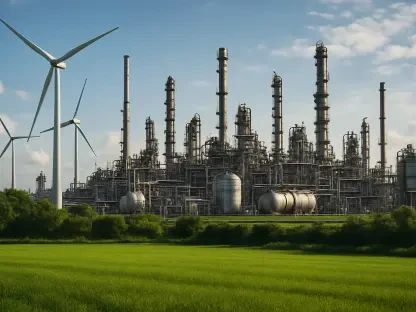Imagine a nation where the hum of data centers powering artificial intelligence, the silent glide of electric vehicles, and the resurgence of manufacturing all converge to create an unprecedented demand for electricity. This is the reality facing U.S. electric utilities today, as they stand on the brink of a staggering $1.1 trillion investment wave over the next five years, from 2025 to 2029. This roundup dives into diverse perspectives from industry analysts, technology forecasters, and energy policy experts to unpack the motivations, challenges, and potential outcomes of this historic capital expenditure. The goal is to provide a comprehensive view of what this boom means for energy security, economic growth, and sustainability in America.
Capital Surge in Electric Utilities: A Multi-Stakeholder Perspective
The scale of investment planned by investor-owned electric utilities is nothing short of monumental, with projections estimating over $1.1 trillion in capital spending through 2029. Industry leaders describe this as a critical response to evolving energy needs, surpassing the pace of the $1.3 trillion invested over the prior decade. This accelerated expenditure signals a transformative era for the sector, positioning it as a cornerstone of national infrastructure development.
Insights from financial analysts highlight the competitive edge this investment could bring, outpacing other capital-intensive sectors like transportation. Many emphasize that the focus is not just on quantity but on strategic allocation to meet modern challenges. This perspective underscores a shared optimism about the sector’s ability to drive economic vitality through enhanced energy capacity.
A contrasting view from regulatory watchdogs raises questions about the sustainability of such rapid spending. Some caution that while the ambition is commendable, the risk of overextending resources looms large if demand projections falter. This diversity of opinion sets the stage for a deeper exploration of what fuels this investment surge and how it might reshape the energy landscape.
Key Drivers Behind the Investment Wave: Diverse Opinions
Data Centers and Skyrocketing Power Needs
One of the most discussed drivers of electricity demand is the explosive growth of data centers, particularly those supporting AI and digital innovation. Technology forecasters project an annual growth rate of around 20% in power needs through 2030, with some estimates suggesting a jump from current levels to as much as 220 gigawatts. This bullish outlook paints a picture of an insatiable appetite for energy in the tech sector.
However, not all analysts agree on the scale of this growth. More conservative estimates from energy consultants suggest a range of 16.5 to 65.3 gigawatts by 2030, pointing to uncertainties around whether all planned data centers will actually be built. This discrepancy highlights a critical debate about separating hype from realistic planning in utility investments.
Policy experts add another layer, noting that the infrastructure required to support data centers must balance speed with reliability. Concerns linger over whether utilities can scale up fast enough without compromising grid stability. This mix of enthusiasm and caution reflects the complex stakes involved in meeting tech-driven energy demands.
Electrification and Economic Expansion as Catalysts
Beyond technology, broader trends like the electrification of transportation and the reshoring of manufacturing are pushing utilities to expand capacity. Economic analysts point to regional growth across the U.S. as a key factor, with new industrial hubs demanding consistent power supplies. This paints a picture of utilities as enablers of a revitalized American economy.
Some industry observers stress the long-term benefits of aligning utility growth with these trends, suggesting that the sector could become a leader in sustainable economic development. Examples include the rise of electric vehicle charging networks, which require robust grid enhancements. This view sees investment as an opportunity to future-proof energy systems.
On the flip side, risk assessors warn of potential overinvestment if economic growth slows or electrification adoption lags. They argue for a measured approach to capacity building, ensuring that utilities don’t overcommit to projects that may not yield expected returns. This balanced dialogue reveals the high stakes of aligning energy planning with economic realities.
Renewable Energy’s Role in the Investment Mix
The push toward renewable energy sources is a central theme in utility investment strategies, with significant capacity additions in solar and storage reported recently. Energy transition advocates celebrate the surge in solar installations and battery storage, viewing these as evidence of a genuine shift toward sustainability. They argue that renewables are essential for meeting both environmental and demand goals.
Yet, some grid reliability experts note a decline in natural gas and wind capacity additions, alongside a recent pivot to gas for data center reliability. This raises questions about whether renewables alone can shoulder the burden of soaring demand. The tension between green ambitions and practical energy needs remains a hot topic among stakeholders.
Environmental policy analysts offer a middle ground, suggesting that a hybrid approach combining renewables with selective gas use could bridge the gap. They emphasize the importance of regional variations in adoption rates, which shape how utilities prioritize investments. This nuanced perspective underscores the challenge of balancing innovation with immediate energy security.
Infrastructure Upgrades and Customer Affordability Concerns
A critical focus of this investment wave is upgrading infrastructure to ensure reliability while keeping costs manageable for consumers. Utility planners stress the importance of modernizing grids to handle increased loads, arguing that strategic spending can prevent outages and enhance service quality. This viewpoint prioritizes resilience as a core outcome of the investment boom.
Contrasting opinions from consumer advocates highlight the risk of passing on high costs to end users, especially if investments outpace demand. They call for transparency in how funds are allocated, ensuring that affordability remains a guiding principle. This concern shapes public and regulatory attitudes toward utility projects.
Economic consultants provide a broader lens, suggesting that affordability debates could influence the pace of investment approvals. They note that public perception plays a significant role in garnering support for large-scale projects, urging utilities to communicate the long-term benefits of their plans. This multifaceted discussion reveals the delicate balance between progress and pragmatism.
Strategic Insights for Navigating the Energy Future
Synthesizing these varied perspectives, it’s clear that the $1.1 trillion investment by U.S. electric utilities responds to urgent demands from data centers, electrification, and economic growth, while pivoting strongly toward renewable energy. Industry stakeholders largely agree on the need for flexible capacity planning to adapt to uncertain forecasts. This approach allows utilities to scale operations based on real-time needs rather than speculative projections.
Another shared takeaway is the importance of balancing renewable energy growth with reliability solutions like targeted natural gas use. Many experts advocate for diversified energy portfolios to mitigate risks associated with over-reliance on a single source. This strategy could serve as a blueprint for sustainable expansion.
For policymakers, industry leaders, and other stakeholders, engaging with this transformation means supporting policies that incentivize smart investments and foster innovation. Collaborating on grid modernization initiatives and advocating for balanced energy mixes are practical steps to ensure the sector’s success. These insights offer a roadmap for navigating the complexities of this historic investment surge.
Reflecting on a Pivotal Moment in Energy Investment
Looking back on the discussions surrounding this massive $1.1 trillion commitment, it becomes evident that U.S. electric utilities stand at a crossroads of opportunity and challenge. The diverse opinions from analysts, forecasters, and advocates illuminate the intricate interplay of technology, economy, and sustainability that shape their strategies. Each perspective adds depth to understanding how this investment wave unfolds as a response to pressing national needs.
Moving forward, a key step is to monitor demand trends closely, adjusting investment plans to avoid overextension or shortfall. Stakeholders should also prioritize research into hybrid energy solutions that blend renewables with reliable backups, ensuring grid stability. Exploring public-private partnerships could further ease the financial burden while accelerating infrastructure projects, paving the way for a resilient energy future.









